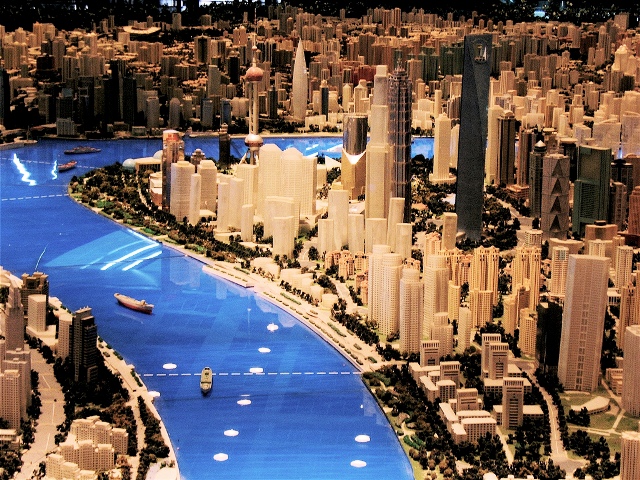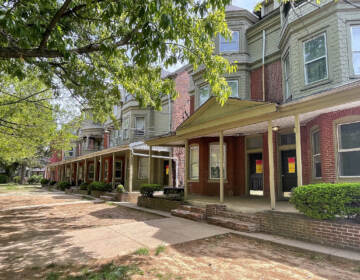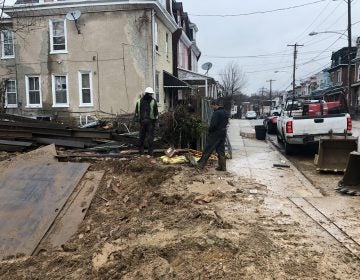Encouraging urban migration part of the plan

Nov. 11
By Thomas J. Walsh
For PlanPhilly
Try your hand at city planning within this scenario: You’ve got a very large Asian metropolis. It’s getting bigger, exponentially, everyday. In fact, the government is encouraging your fellow citizens from other parts of the country to move there. You have to accommodate the influx while making room for an explosion in growth among your town’s universities and new industries, such as auto manufacturing.
On top of that, there’s a global economic slowdown to deal with and a new government mandate to green your inner city so that about 30 percent of it is open space or parks.
An impossible job? Should you build underground tunnels coupled with soaring skyscrapers? Resort to sprawl?
The answer to this real-world problem in Shanghai, China, is to build additional cities – satellite towns, really, not suburbs – surrounding the original urban core.
Nine of them. Nine new cities, each with a capacity of about a million people.
“Our strategy in Shanghai is to try to figure out how to newly organize the city,” said Jiang Wu, deputy director general of the Shanghai Urban Planning Administration Bureau. “We must think about moving new industries into them. We can attract more people. It isn’t just about Shanghai itself. We also have a duty to support the whole country’s economy. That means attracting new people from the rural places.”
It was something of an eye-opener. Jiang’s comments were matter-of-fact, with a detailed PowerPoint, and stood in contrast to the generally negative connotations associated with the massive rural-to-urban migration taking place in the Third World and developing nations.
“We have to face this problem along with other problems that you probably faced 100 or 200 years ago – the rapid industrialization and urbanization of the country,” Jiang said. “We have had modernization only within the past 20 years. … For the Chinese people, industrialization, modernization and urbanization have the same meaning – that is, they want to have the same lifestyle as people in the current industrialized nations.”
So far, three of the cities are under construction: Jiading-Anting is slated to be automobile manufacturing base; Songjiangt is designated to accommodate the expanding universities; and Lingang, southeast of the main city on the Huangpu River, will be a new port city.
About 10 million people live in downtown Shanghai, Jiang said, within 373 square miles. “People have low income, but compared with their previous lives in the countryside, it’s much higher. Rural people are changing their lifestyle to live and produce in a different way.”
Agglomeration nation
Jiang spoke early last Saturday morning as city managers from around the world gathered at the University of Pennsylvania to take part in a discussion focused on innovative responses to climate change and alternative energy strategies for cash-strapped cities. Andrew Altman, Philadelphia’s deputy mayor for planning and commerce, moderated Jiang’s panel.
In describing Shanghai’s growth management, Jiang made clear that the Chinese transition from an agrarian economy into a more diversified, decentralized financial system is underway.
“Agricultural development and urbanization are inextricably linked,” wrote Neil Pierce and Curtis Johnson, in their book “Century of the City,” published this year by the Rockefeller Foundation, a co-sponsor of the conference where Jiang spoke. “For most of the last century, however, leaders in the Global South and many development institutions did not work effectively to integrate this economic reality into development priorities.”
Last Saturday was the final day of a “Re-imagining Cities” symposium co-sponsored by the Penn Institute for Urban Research and the Penn School of Design, subtitled “Urban Design After the Age of Oil.”
A result of that “mal-development,” the authors wrote, manifested itself in the proliferation of urban slums, home of more than 1 billion people around the world. They quote a senior member of the People’s Bank of China (akin to our Federal Reserve) who said the shift in thinking on the part of the Chinese government has taken place only within the past 10 years, as it slowly grasped “agglomeration efficiencies” and “the key role of urbanization in structural transformation.”
Part of that recognition incorporates environmental design and engineering, an effort to reverse the course of rapid coal- and oil-based industrialization, the effects of which the Chinese government worked so hard to mitigate during last summer’s Olympic Games in Beijing. By 2020, Jiang said, one goal for Shanghai is that more than 30 percent of the city’s land will be covered by parkland. Under the plan, public green space per capita within Shanghai – and its offspring towns – would be increased to the point where no residence is more than 50 meters from a park.
This is especially important, Jiang said, because as Chinese citizens become wealthier, the number of cars in the country will increase dramatically, no matter the future fuel situation. That said, another environmentally friendly tool – Shanghai’s already large metro railway system – is set to gain an additional 19 lines. In 2010, the city will host the Shanghai World Expo, with the theme, “Better City, Better Life!”
“For the first time in history, it’s the intermediate cities that are the ones growing the most,” said Jonas Rabinovitch, a Brazilian architect, urban planner and fellow panelist who is the senior urban development adviser for the United Nations. “We have literally hundreds of thousands of cities in the world that can take the wrong path or the right path.”
Infrastructure envy
Joining Jiang and Rabinovitch on the panel was Clive Doucet, an urban activist, author and city councilor in Ottawa, Canada. He said cities are suffering several crises at once: a social crisis of income inequality; a municipal financial crisis (brought into bas-relief last week by Philadelphia’s headline-making budget woes); an ecological crisis; and a political crisis.
“The first three cannot be solved unless the political crisis is solved first,” Doucet said.
To that end, only hours after the conference was brought to a close by Gary Hack, dean emeritus of the Penn School of Design and former executive director of the Philadelphia City Planning Commission, major news from Shanghai had spread. By 2010, the Chinese government will spend about $586 billion on a vast national infrastructure and social welfare initiative that will include the redevelopment of depressed urban communities, new railways, subways and airports.
The economic stimulus package is similar in its size and goals to a plan that most attending last week’s conference would love to see implemented by President-elect Barack Obama. It was announced Sunday by China’s State Council, according to the New York Times.
The plan is “aimed at bolstering [China’s] weakening economy and perhaps helping fight the effects of a global economic slowdown,” the article said. It “is the largest economic stimulus effort ever undertaken by the Chinese government and would amount to about 7 percent of the country’s gross domestic product during each of the next two years. Beijing also said it was loosening credit and encouraging lending.”
Contact the reporter at tom@thomasjwalsh.info.
On the Web:
Shanghai World Expo: http://en.expo2010china.com/
“China Unveils $586 Billion Economic Stimulus Plan” (New York Times): http://www.nytimes.com/2008/11/10/world/asia/10china.html?_r=1&hp&oref=slogin
Conference Web site: http://www.upenn.edu/penniur/afteroil/home.html
WHYY is your source for fact-based, in-depth journalism and information. As a nonprofit organization, we rely on financial support from readers like you. Please give today.





